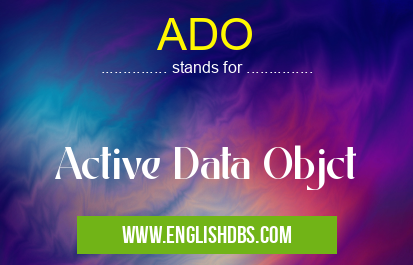What does ADO mean in DATABASES
Active Data Objects (ADO) is a component object model (COM) library that provides access to data sources through an object-oriented programming interface. Created by Microsoft, ADO is used in software development to interact with databases and data sources. It allows developers to create, modify, and query data, as well as to manage connections and transactions.

ADO meaning in Databases in Computing
ADO mostly used in an acronym Databases in Category Computing that means Active Data Objct
Shorthand: ADO,
Full Form: Active Data Objct
For more information of "Active Data Objct", see the section below.
Features of ADO
-
Provides a uniform programming interface for accessing different data sources, including relational databases, flat files, and XML documents.
-
Supports various data types and data manipulation operations, such as CRUD (Create, Read, Update, Delete) operations, data navigation, and sorting.
-
Enables data binding, allowing developers to connect data sources to user interface elements for data display and manipulation.
-
Offers support for data caching, transactions, and asynchronous data operations, ensuring efficient data handling and performance.
-
Provides a rich set of programming objects, including
Connection,Command,Recordset, andParameter, which represent different aspects of data access.
Benefits of Using ADO
-
Simplifies data access programming by providing a consistent and easy-to-use interface for interacting with different data sources.
-
Enhances productivity by automating many data access tasks, such as connection management and data retrieval.
-
Improves application performance through optimized data caching and asynchronous operations.
-
Facilitates data binding, enabling seamless integration of data into user interfaces.
-
Supports various development languages and environments, including Visual Basic, C++, and .NET.
Essential Questions and Answers on Active Data Objct in "COMPUTING»DB"
What is ADO?
ADO (Active Data Objects) is a Microsoft technology that provides a set of COM objects for accessing and manipulating data from various data sources. It allows developers to create database-independent applications that can connect to and interact with multiple data sources.
What are the benefits of using ADO?
ADO offers several benefits, including:
- Database independence: It allows applications to connect to and interact with different types of databases, such as SQL Server, Oracle, and Access, without requiring specific drivers or knowledge of the underlying database structure.
- Simplified data access: It provides a consistent and easy-to-use interface for accessing and manipulating data, making it easier for developers to write database-related code.
- Increased performance: ADO utilizes connection pooling and other optimizations to improve the performance of database operations.
What are the different ADO components?
Key ADO components include:
- Connection: Represents the connection to a specific data source.
- Command: Used to execute commands against a data source, such as SELECT, INSERT, and UPDATE.
- Recordset: Represents a set of records retrieved from a data source.
- Parameter: Used to pass values to commands and procedures.
- DataShape: Provides a schema-less interface for representing and manipulating data.
How do I use ADO in my applications?
To use ADO, you need to:
- Establish a connection to the data source using the Connection object.
- Create a Command object to specify the SQL statement or stored procedure to execute.
- Create a Recordset object to retrieve the results of the command execution.
- Use the DataReader or DataAdapter objects to access and manipulate the data in the Recordset.
What is the difference between ADO and ADO.NET?
ADO.NET is the successor to ADO and is built on the .NET Framework. While ADO is a COM-based technology, ADO.NET is object-oriented and provides a more modern and efficient approach to data access. ADO.NET also supports a wider range of data sources and offers additional features such as disconnected data access and data binding.
Final Words: ADO is a powerful and versatile data access technology that has been widely adopted in software development. Its object-oriented approach, comprehensive feature set, and ease of use make it an ideal choice for accessing and manipulating data from a variety of sources. By leveraging ADO, developers can streamline data access tasks, enhance application performance, and improve the overall user experience when it comes to data-driven applications.
ADO also stands for: |
|
| All stands for ADO |
